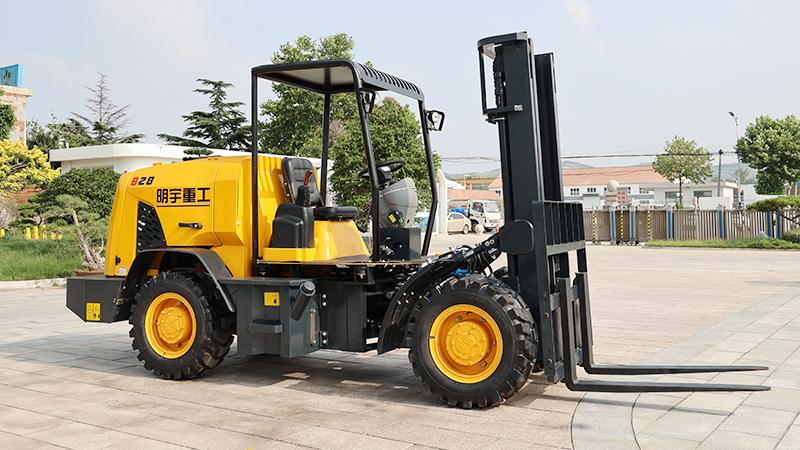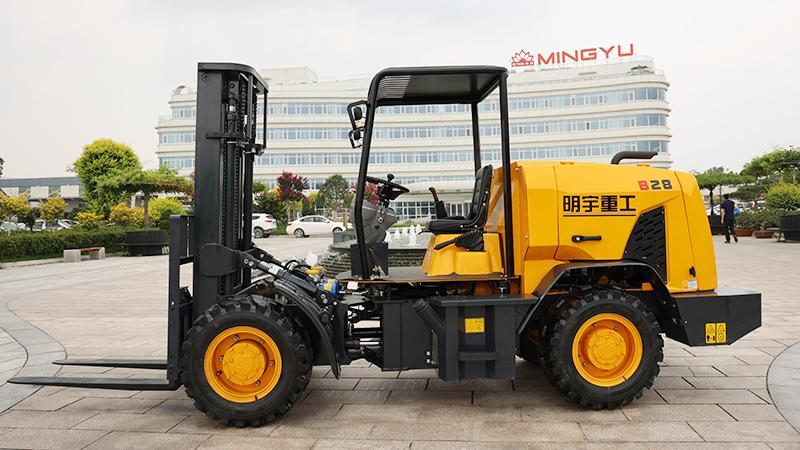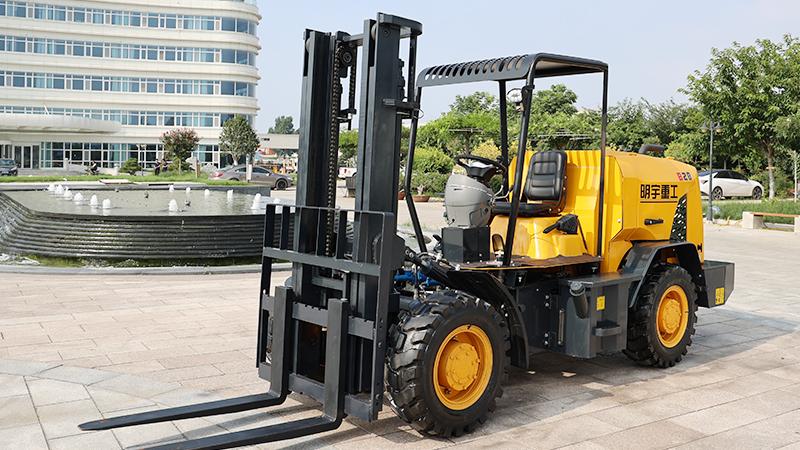In the realm of industrial machinery and material handling, the rough terrain forklift stands as a pivotal piece of equipment, engineered specifically to operate efficiently in challenging outdoor environments where conventional warehouse forklifts would falter. Unlike their indoor counterparts, which are designed for smooth, paved surfaces, rough terrain forklifts are characterized by their robust construction, large, heavy-duty tires, and enhanced stability, allowing them to navigate uneven ground, muddy fields, construction sites, and other rugged landscapes with relative ease. The primary purpose of these machines is to lift, transport, and place heavy loads in conditions that are typically considered too demanding for standard forklifts. Industries such as construction, agriculture, lumber, and large-scale infrastructure projects rely heavily on these versatile vehicles. A notable example in this category is the MYZG model, which embodies the core attributes of durability and high performance. The MYZG rough terrain forklift is designed to handle substantial weights, often ranging from 5,000 to 35,000 pounds, and is equipped with features like four-wheel drive, powerful engines, and reinforced masts that provide the necessary torque and lift capacity for demanding tasks. The essence of a rough terrain forklift lies in its ability to maintain operational integrity where the ground is unpredictable—be it gravel, sand, dirt, or inclines. This capability is not merely about mobility; it is about ensuring that critical materials such as steel beams, concrete pipes, lumber stacks, or agricultural pallets can be moved safely and efficiently from delivery points to precise locations on a worksite. Without such equipment, projects in these sectors would face significant delays, increased labor costs, and heightened safety risks. The MYZG model, in particular, integrates advanced hydraulic systems and operator-centric cabins to enhance control and reduce fatigue, thereby optimizing productivity in prolonged operations. Thus, the rough terrain forklift, exemplified by the MYZG, is primarily a solution for material handling in the great outdoors, where it bridges the gap between logistical needs and environmental challenges, proving indispensable for progress in various heavy industries.
The construction industry represents one of the most significant domains where rough terrain forklifts, including the MYZG brand, are indispensable. On any construction site, whether it involves erecting skyscrapers, building bridges, or developing residential complexes, the movement of heavy and bulky materials is a constant requirement. These materials—such as rebar, scaffolding, pre-cast concrete panels, and large tools—need to be transported across grounds that are often unpaved, littered with debris, and subject to weather changes like rain or snow, which can turn the terrain muddy and unstable. A rough terrain forklift is specifically designed to tackle these conditions. Its large, pneumatic tires provide excellent traction and flotation on soft ground, while its robust chassis and suspension absorb shocks from bumps and holes. The MYZG model, for instance, often includes features like oscillating axles or all-wheel steering, which improve stability and maneuverability on rough surfaces. This ensures that loads remain secure and the risk of tipping is minimized. Moreover, the lifting capabilities of these forklifts allow them to place materials at height, such as loading items onto scaffolding or stacking supplies on upper floors during the initial phases of construction. The versatility of attachments—like forks, booms, or clamps—further extends their utility, enabling them to handle a variety of shapes and sizes. In infrastructure projects such as road building or pipeline installation, rough terrain forklifts are used to move heavy pipes, drainage culverts, and equipment across long, uneven stretches. The MYZG rough terrain forklift, with its durable engine and high torque output, can operate continuously in such demanding settings, reducing reliance on multiple machines and streamlining workflows. Essentially, in construction, the rough terrain forklift is not just a lifting device; it is a multi-functional tool that supports the entire material handling chain, from unloading trucks to positioning components precisely where needed, thereby accelerating project timelines and enhancing on-site safety.
Beyond construction, rough terrain forklifts like the MYZG find critical applications in agriculture, forestry, and other resource-based industries where outdoor material handling is a daily necessity. In agricultural settings, these forklifts are used for tasks such as moving large bales of hay, transporting pallets of feed or fertilizer, and handling bulk produce from fields to storage or processing areas. Farms often have terrain that includes dirt tracks, grassy fields, and muddy patches, especially after rainfall, which can immobilize standard forklifts. The rough terrain variant, with its high ground clearance and aggressive tire treads, navigates these areas effortlessly. The MYZG model, for example, may offer enhanced hydraulic controls for gentle handling of delicate loads like harvested fruits or vegetables, preventing damage during transit. In lumber yards and forestry operations, the ability to move stacks of logs, timber, or wood chips across uneven, often sloped ground is crucial. Here, the rough terrain forklift's strength and stability allow it to carry heavy loads safely, reducing manual labor and the risk of injuries. Additionally, in industries like mining or quarrying, though more specialized equipment might be used, rough terrain forklifts assist in handling supplies, equipment parts, and extracted materials in peripheral areas. The MYZG rough terrain forklift's durability ensures it can withstand dusty, abrasive environments and operate reliably over long shifts. Its engine is typically designed for high efficiency, providing the power needed for lifting while managing fuel consumption—a key consideration in remote locations. Furthermore, in large-scale warehousing that extends outdoors, such as storage yards for steel, bricks, or machinery, these forklifts enable efficient stacking and retrieval of goods without the need for perfectly level ground. The adaptability of the MYZG model to various attachments, like side-shifters or rotators, makes it suitable for handling diverse materials, from cylindrical objects to irregularly shaped items. Thus, in agriculture and similar sectors, the rough terrain forklift serves as a backbone for logistics, ensuring that materials flow smoothly from production points to utilization areas, thereby supporting operational continuity and economic efficiency.
The integration of rough terrain forklifts into modern industrial practices underscores their importance in enhancing productivity, safety, and versatility. As technology advances, models like the MYZG continue to evolve, incorporating innovations such as telematics for fleet management, ergonomic operator cabins with climate control and reduced noise levels, and environmentally friendly engines that meet emission standards. These improvements not only boost performance but also align with broader trends toward sustainability and worker well-being. The primary use of a rough terrain forklift—to facilitate material handling in tough outdoor conditions—remains unchanged, but its execution becomes more refined. For instance, the MYZG rough terrain forklift might include advanced safety features like load moment indicators, stability control systems, and cameras for better visibility, which are critical in preventing accidents on unpredictable terrain. Moreover, the economic impact of these machines is substantial; by enabling faster material movement and reducing downtime due to terrain issues, they contribute significantly to cost savings and project profitability. In emergency scenarios, such as disaster recovery or military logistics, rough terrain forklifts are deployed to move debris, supplies, or equipment in areas where infrastructure is compromised. The MYZG model's reliability and power make it suitable for such high-stakes environments. Looking ahead, the demand for rough terrain forklifts is likely to grow with increasing construction activities, agricultural mechanization, and infrastructure development worldwide. The MYZG brand, by focusing on durability, adaptability, and user-friendly design, is well-positioned to meet this demand. In summary, the rough terrain forklift, particularly the MYZG, is primarily used for lifting and transporting heavy loads in outdoor, uneven terrains across industries like construction, agriculture, and logistics. It is an essential tool that transforms challenging material handling tasks into manageable operations, driving efficiency and progress in some of the most demanding work settings.
Post time:Oct.09.2025



